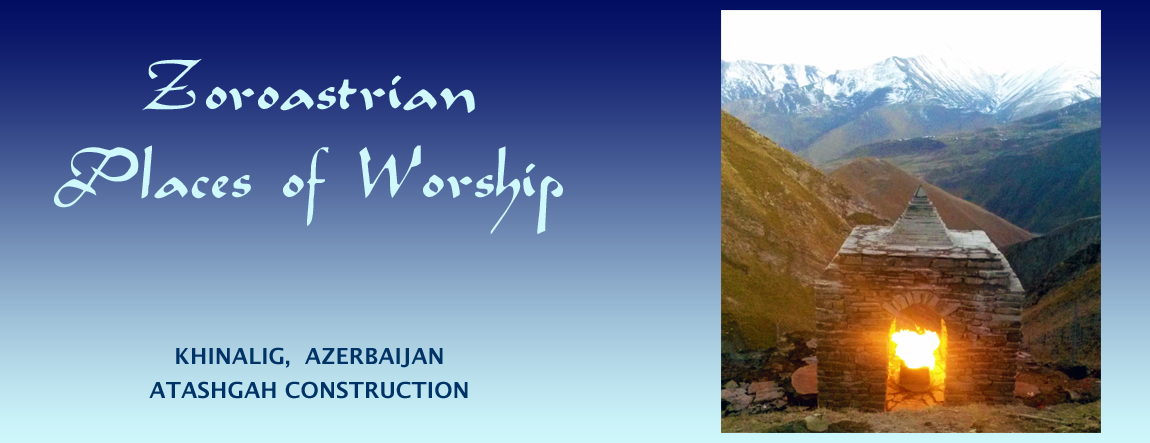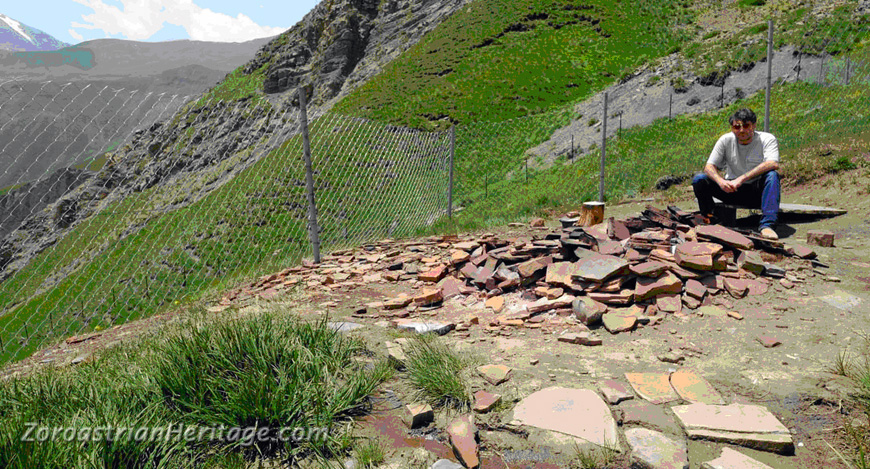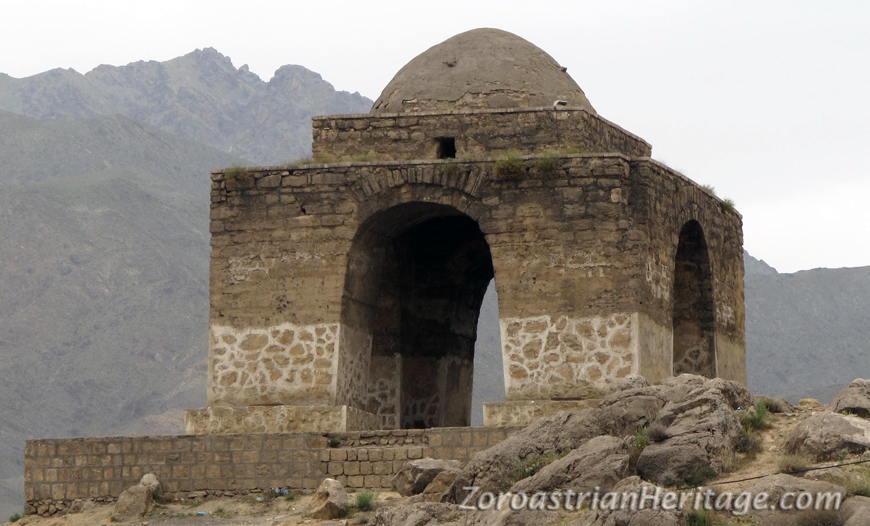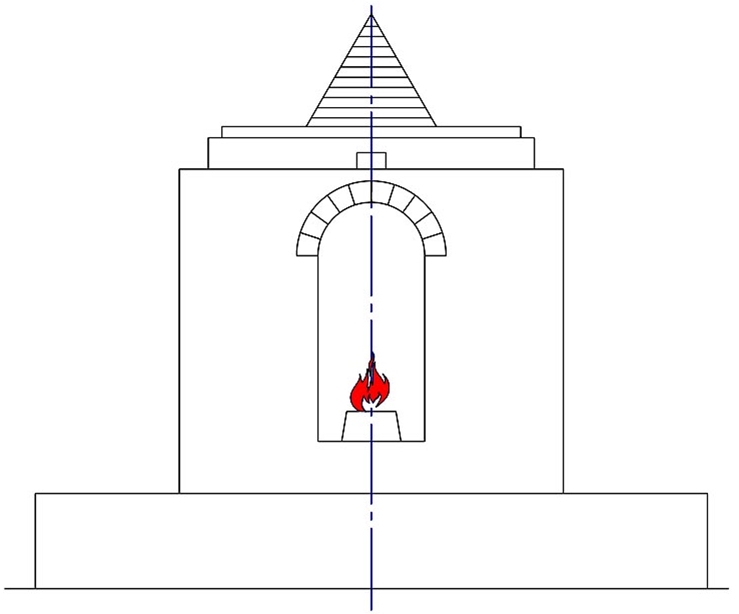
Contents

Khinalig Atashgah
Page 1 - Background
Page 2 - Construction Beginnings
Page 3 - Photographic Tour of the Construction
Related Pages
Azerbaijan's Dakhmas
Surakhani, Azerbaijan, Atashgah
Page 2 - Khinalig Atashgah Construction - Beginnings
Suggested prior reading:
» Pg.1-Khinalig Village, People & Atashgah Background
» Caucasia
» Azerbaijan
» Early Zoroastrian Fire Houses & Temples
Related reading:
» Surakhani, Azerbaijan, Atashgah
» Darband Sasanid Fortress
» Shamkir Achaemenid Era Ruins
» Azerbaijan Historic Sites
Farroukh Jorat's Goal
|
On October 5, 2016 a team of dedicated and praise-worthy pioneers led by Farroukh Jorat an engineer from Baku (the capital of the Republic of Azerbaijan) completed the reconstruction of an Atashgah, a House of Fire - otherwise a Zoroastrian Fire Temple - at the site of an ancient Atashgah* at Khinalig**, the highest village in the Republic of Azerbaijan.
[Atashgah is also spelt Ateshgah. **Khinalig is also spelt Xinaliq, Khinalug, Khinalyg & Khinalugh.] |
Farroukh Jorat of Azerbaijan set himself a goal: to restore the forgotten Fire Temples of his country.
In Azerbaijan, it was well known that in a hill close to the village of Khinalig, a fire burned continuously fed by natural gas emanating from the ground. The village residents had called the site an Atashgah for as long as anyone could remember and they considered the site and its flame to be sacred. The Atashgah was also was also known as a pir - an old and holy place. People go to pirs to offer prayers even though such a practice is forbidden by the religion most professed - Islam.
Jorat selected Khinalig's hillside Atashgah as the place to start the journey of achieving his goal by constructing a building over the flame. He procured local and official consent, organized a team to do the design and construction work, and procured funding for the project from the WZO, the World Zoroastrian Organization based in London, England and the Firuz Madon Foundation.
[Source: Jorat, Farroukh - 'Zoroastrianism in Northern Shirvan']

|
| Farroukh Jorat at the Khinalig hillside Atashgah. Image credit: Fariz Abasov. |
Jorat met Fariz Abasov, a journalist from Baku with family ties to Khinalig, and the reconstruction team began to take shape.
Atashgah Chahar-Taqi Design
Inspired by the chahar-taqi (four-arched) Atashgah at Surakhani near Baku, Azerbaijan's capital, Jorat decided on a chahar-taqi design for his proposed Khinalig Atashgah building. (For more on chahar-taqi Atashgahs, see our page on Early Zoroastrian Fire Houses & Temples.
There are several abandoned Sasanid era chahar-taqi Fire Temples and ruins spread across Iran and from amongst these Jorat and his team chose the chahar-taqi at Niasar near Kashan, Esfahan (Isfahan).

|
| Chahar-Taqi Atashgah at Niasar near Kashan, Esfahan (Isfahan). Image Credit: Photographer unknown. |
Chahar-Taqi Temple's Alignment/Orientation
The walls or pillars of many a Sasanid-era chahar-taqi Atashgah are aligned in some fashion with the solar-based cardinal points or with the position of the Sun during the equinoxes and solstices. This observation has led some to believe that besides serving as places of worship, the Atashgahs served an additional function - that of using the position of the sun at sunrise, noon or sunset to determine the start of the seasons by determining the day of a solstice or an equinox. It is only necessary to precisely determine one of the annual equinoxes or solstices after which a 365 day calendar can determine the rest of the days. A calendar that starts with such an observation will be self-adjusting for leap years.
After, say the spring equinox or the summer solstice to deemed to have occurred by observation of the alignment of the part of the Atashgahs structure with the passage of the Sun's light through the structure, it would also be possible to determine and fix those days of the year with religious significance. These days are the jashnes or jashans - days Zoroastrians mark with specials prayers and festivals. Other days of importance to the community that can also be determined as those that help farmers determine the correct time to sow crop seeds.
The path of the Sun's rays in the Khinalig Atashgah during the solstices is shown below.

|
| The orientation of the Khinalig Chahar-Taqi Atashgah to the Sun during solstices and equinoxes. Credit: Dorna Soroush, architect. |
Initial Design Drawings

|
| Initial drawings of the proposed Khinalig Atashgah. Note the hemispherical dome. Credit: Dorna Soroush, architect. |
The Khinalig structure was originally designed to have a domed roof with a shape commonly used in Sasanid times.
[Our note: It is a common assumption that domed places of worship are an Islamic invention. However, domed structures of all types were prolific throughout Aryana long before the advent of Islam. Since many Fire Temples are said to have been converted to mosques, perhaps it is through this route that domes came to be associated with mosques. The shape of the dome could have evolved after the Arab conquest of Aryana to the shape we are familiar with today.]
Openings in the base wall of the dome were designed above each of the four arches to aid the venting of gases produced in the burning of the flame. Removing these gases that would otherwise collect under the roof would help the flame rise and grow in size thereby becoming visible from a distance.
Design Modifications
After the Atashgah structure's drawings were sent to the the Ministry of Culture and Tourism for approval, the designated approving authority, Dr. Idris N. Aliyev provisionally approved of the building subject to the following required changes:
1) The hemispherical dome had to be replaced with a pyramid dome structure in accordance with the local historical traditions;
2) The structure was required to have a pedestal-like base similar to the one used for the Niasar chahar-taqi Atashgah (see above). This enlarged base would mitigate against landslides and any land subsidence (sinking), and
3) The mouth of the flame crater needed to rise above the floor by two feet in order to prevent the flame mouth being flooded by snow melt;
It was also decided to reduce the overall size of the Atashgah.
The redesigned Atashgah is shown below:

|
| The redesigned Khinalig Atashgah. Credit: Farroukh Jorat. |
Funding
Farroukh Jorat applied to the World Zoroastrian Organization (WZO - Mr. Shahpur Captain, Chairman) for funds to construct the Atashgah. The WZO together with the Firuz Madon Foundation agreed to sponsor the project.
Assembly of the Construction Team
The director of the Khinalig Village Museum and a school teacher, Hasan Aghayev, had shown great enthusiasm for the Atashgah project. He offered to assemble and lead a team of four construction workers from Khinalig.
In our next page, we take a photographic tour of the construction process.
» Previous Page 1 - Khinalig Atashgah & Village Background